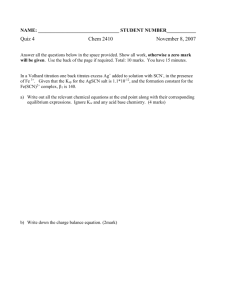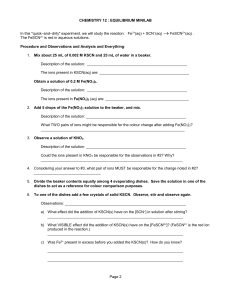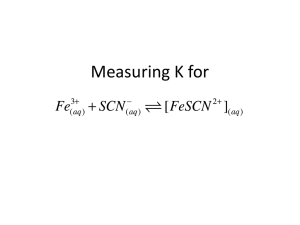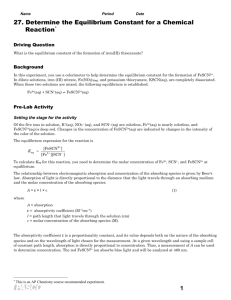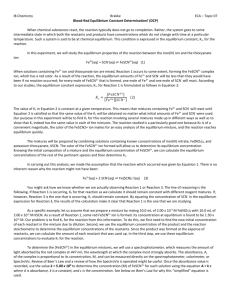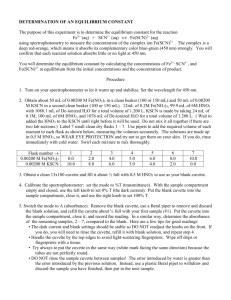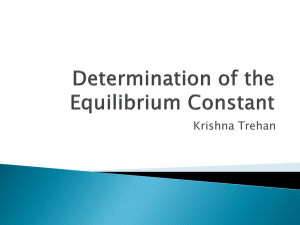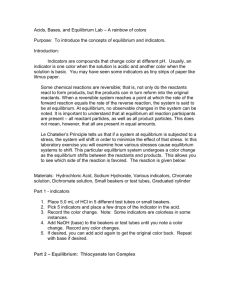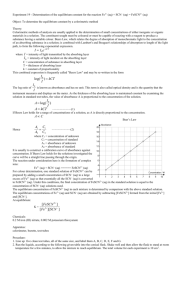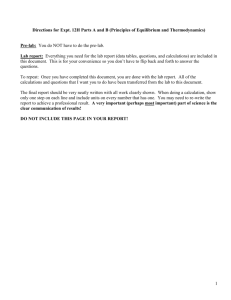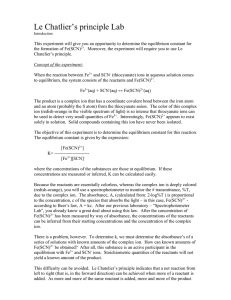Spectrophotometric Determination of an Equilibrium Constant
advertisement
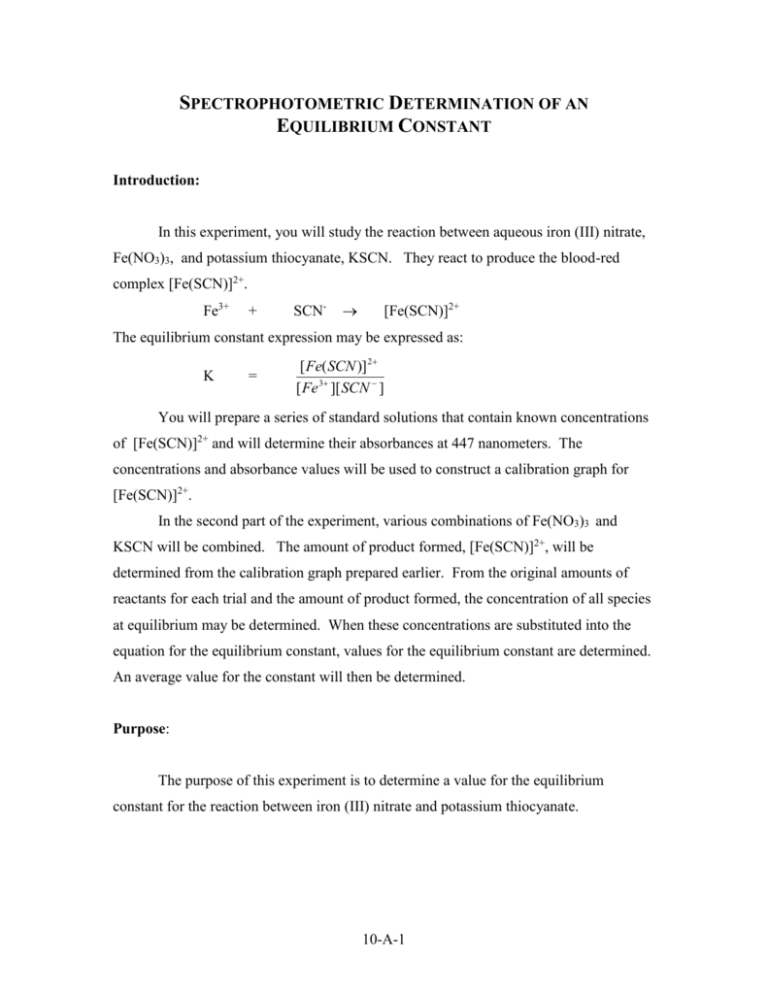
SPECTROPHOTOMETRIC DETERMINATION OF AN EQUILIBRIUM CONSTANT Introduction: In this experiment, you will study the reaction between aqueous iron (III) nitrate, Fe(NO3)3, and potassium thiocyanate, KSCN. They react to produce the blood-red complex [Fe(SCN)]2+. Fe3+ + SCN- [Fe(SCN)]2+ The equilibrium constant expression may be expressed as: K = [ Fe( SCN )] 2 [ Fe 3 ][ SCN ] You will prepare a series of standard solutions that contain known concentrations of [Fe(SCN)]2+ and will determine their absorbances at 447 nanometers. The concentrations and absorbance values will be used to construct a calibration graph for [Fe(SCN)]2+. In the second part of the experiment, various combinations of Fe(NO3)3 and KSCN will be combined. The amount of product formed, [Fe(SCN)]2+, will be determined from the calibration graph prepared earlier. From the original amounts of reactants for each trial and the amount of product formed, the concentration of all species at equilibrium may be determined. When these concentrations are substituted into the equation for the equilibrium constant, values for the equilibrium constant are determined. An average value for the constant will then be determined. Purpose: The purpose of this experiment is to determine a value for the equilibrium constant for the reaction between iron (III) nitrate and potassium thiocyanate. 10-A-1 Equipment/Materials: Spec 20 or similar spectrophotometer 0.00200 M KSCN 0.200 M Fe(NO3)3 0.00200 M Fe(NO3)3 0.05 M HNO3 burets or pipets 50 mL beakers cuvets Safety: An apron and goggles should always be worn in the lab. Procedure: 1. The chart below provides the volumes of reactants needed to prepare the standard solutions. Notice that the concentration of the iron solution is much greater than that of the KSCN solution. This is to ensure that all of the KSCN is used up in the reaction. The concentration of the product will be determined from the volume and concentration of the KSCN used in each trial. Solution 0.00200 M KSCN 0.200 M Fe(NO3)3 0.05 M HNO3 1 1.0 mL 1.0 mL 3.0 mL 2 0.8 mL 1.0 mL 3.2 mL 3 0.6 mL 1.0 mL 3.4 mL 4 0.4 mL 1.0 mL 3.6 mL 5 0.2 mL 1.0 mL 3.8 mL 2. Turn on the spectrophotometer and allow it to warm up. Set the wavelength to 447 nm. Use a cuvet filled with the 0.05 M HNO3 as the blank. Follow your instructor’s directions to measure the absorbance values for each of the solutions prepared in Step 1. Record all the values in your data table. 10-A-2 3. Construct a calibration curve for the data collected in Step 2. Plot absorbance on the y-axis and concentration of [Fe(SCN)2+] on the x-axis. Draw a best-fit line though the data points. This graph will be used to determine the amount of product formed in the next step. 4. Use a buret or pipet to measure the volumes of the reactants listed below. Note that this set of combinations uses the more dilute Fe(NO3)3 solution. Solution 0.00200 M Fe(NO3)3 0.00200 M KSCN 0.05 M HNO3 1 2.5 mL 0.5 mL 2.0 mL 2 2.5 mL 1.0 mL 1.5 mL 3 2.5 mL 1.5 mL 1.0 mL 4 2.5 mL 2.0 mL 0.5 mL 5 2.5 mL 2.5 mL 0 5. After the above combinations have been mixed, samples should be poured into clean cuvets. The absorbance of each solution should be measured and recorded in the data table. Using your calibration graph, determine the concentration of [Fe(SCN)2+] for each of the trials. 6. From the concentration of [Fe(SCN)2+] produced and the original concentrations of the reactants, construct tables to determine the equilibrium concentrations of all species. Use these values to calculate the equilibrium constant for each trial. 10-A-3 SPECTROPHOTOMETRIC DETERMINATION OF AN EQUILIBRIUM CONSTANT Data: Part I: For this part of the experiment assume [SCN-] = [FeSCN2+] [SCN-] Trial [FeSCN2+] Absorbance 1. 2. 3. 4. 5. Part II: Trial 1 2 3 Absorbance [FeSCN2+] (from graph) Volume Fe3+ [Fe3+] initial [Fe3+] final Volume SCN[SCN-] initial [SCN-] final 10-A-4 4 5 Calculations: For each of the trials calculate a value for the equilibrium constant. At the end, report the average value for the constant. Trial 1: K = [FeSCN2+] [Fe3+] [SCN-] Trial 2: K = [FeSCN2+] [Fe3+] [SCN-] Trial 3: K = [FeSCN2+] [Fe3+] [SCN-] Trial 4: K = [FeSCN2+] [Fe3+] [SCN-] Trial 5: K = [FeSCN2+] [Fe3+] [SCN-] Average K = ____________________ 10-A-5 Questions: 1. Why is the experiment run at a wavelength of 447 nm? 2. What is the relationship between concentration and absorbance in Part I of the experiment? 3. Why is the Fe2+ concentration so much higher than the KSCN in Part I of the experiment? 4. Extra Credit: Create a spreadsheet using Excel that will calculate the equilibrium constants for this experiment. 10-A-6
